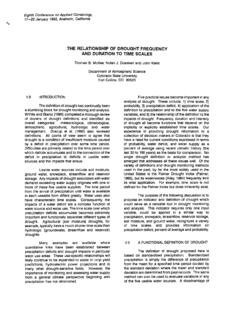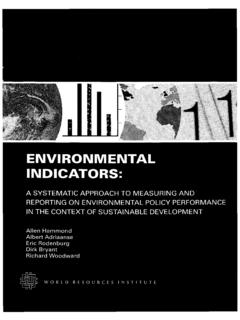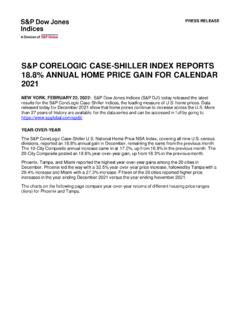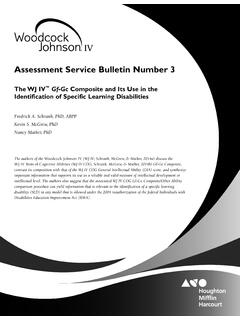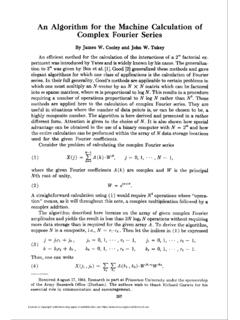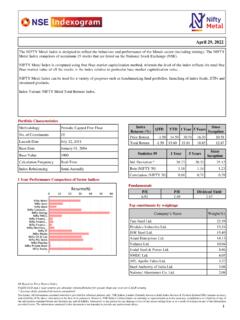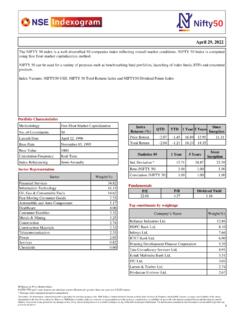Transcription of Handbook of Drought Indicators and Indices
1 Handbook of Drought Indicators and Indices Integrated Drought Management Programme WMO-No. 1173 Towards a water secure world WEATHER CLIMATE WATER. The World Meteorological Organization (WMO) is a specialized agency of the United Nations. It is the United Nations system's authoritative voice on the state and behaviour of the Earth's atmosphere, its interaction with the land and oceans, the weather and climate it produces and the resulting distribution of water resources. WMO has a membership of 191 Member States and Territories. The Global Water Partnership (GWP) is an international network whose vision is for a water secure world. The GWP mission is to advance governance and management of water resources for sustainable and equitable development. The GWP network is open to all organizations that recognize the principles of integrated water resources management endorsed by the network.
2 The National Drought Mitigation Center (NDMC), established at the University of Nebraska- Lincoln in 1995, helps people and institutions develop and implement measures to reduce societal vulnerability to Drought , stressing preparedness and risk management rather than crisis management. NDMC collaborates with many federal, state and international agencies. The Integrated Drought Management Programme (IDMP) was launched by WMO and GWP at the High Level Meeting on National Drought Policies in March 2013. IDMP works with a wide range of partners with the objective of supporting stakeholders at all levels. IDMP provides its partners with policy and management guidance through globally coordinated generation of scientific information and sharing best practices and knowledge for integrated Drought management. It contributes to the Global Framework for Climate Services (GFCS), especially regarding the GFCS priority areas of disaster risk reduction, water, agriculture and food security, energy and health.
3 It especially seeks to support regions and countries in developing more proactive Drought policies and better predictive mechanisms. This Handbook contributes to that objective. Handbook of Drought Indicators and Indices Integrated Drought Management Programme (IDMP). WMO-No. 1173 Towards a water secure world 2016. Note to the reader: This publication is part of the Integrated Drought Management Tools and Guidelines Series', compiled by the Integrated Drought Management Programme (IDMP). This Handbook of Drought Indicators and Indices is based on available literature and draws findings from relevant works wherever possible. The Handbook addresses the needs of practitioners and policymakers. The publication is considered as a resource guide/material for practitioners and not an academic paper. This publication is a living document' and will be updated based on the experiences of its readers.
4 The Indicators and Indices detailed in chapter 7 of the Handbook are also available online at www. IDMP encourages water managers and related experts engaged in the management of Drought around the globe to participate in the enrichment of this publication. For this purpose, comments and other inputs are cordially invited. Authorship and contributions will be appropriately acknowledged. Please kindly submit your inputs to: under Subject: Handbook of Drought Indicators and Indices '. Citation: World Meteorological Organization (WMO) and Global Water Partnership (GWP), 2016: Handbook of Drought Indicators and Indices (M. Svoboda and Fuchs). Integrated Drought Management Programme (IDMP), Integrated Drought Management Tools and Guidelines Series 2. Geneva. Integrated Drought Management Tools and Guidelines Series 2.
5 2016 World Meteorological Organization and Global Water Partnership ISBN 978-92-63-11173-9. ISBN 978-91-87823-24-4. Disclaimer: The designations employed in WMO and GWP publications and the presentation of material in this publication do not imply the expression of any opinion whatsoever on the part of WMOand GWP concerning the legal status of any country, territory, city or area, or of its authorities, or concerning the delimitation of its frontiers or boundaries. The mention of specific companies or products does not imply that they are endorsed or recommended by WMO. and GWP in preference to others of a similar nature which are not mentioned or advertised. The findings, interpretations and conclusions expressed in WMO and GWP publications with named authors are those of the authors alone and do not necessarily reflect those of WMO and GWP or its respective Members.
6 CONTENTS. Page ACKNOWLEDGEMENTS iv 1. INTRODUCTION 1. 2. DEFINITIONS: Indicators VERSUS Indices 3. 3. APPROACHES FOR MONITORING Drought AND GUIDING EARLY WARNING. AND ASSESSMENT 4. 4. SELECTING Indicators AND Indices 5. 5. SUMMARY OF Indicators AND Indices 6. 6. INDEX AND INDICATOR RESOURCES 10. 7. Indicators AND Indices 11. Meteorology 11. Soil moisture 25. Hydrology 27. Remote sensing 32. Composite or modelled 38. APPENDIX: SURVEY RESULTS 42. BIBLIOGRAPHY 44. ACKNOWLEDGEMENTS. The Handbook of Drought Indicators and Indices is an initiative of the Integrated Drought Management Programme (IDMP), and was developed by Mark Svoboda and Brian Fuchs of the National Drought Mitigation Center at the University of Nebraska-Lincoln. Contributions and comments came from the following (in alphabetical order of family name): Kevin Anderson, Climate Data and Analysis Section, Environment Canada Chandrashekhar Biradar, International Center for Agricultural Research in the Dry Areas (ICARDA).
7 Siegfried Demuth, United Nations Educational, Scientific and Cultural Organization (UNESCO). Maxx Dilley, World Meteorological Organization (WMO). Allan Howard, Agriculture and Agri-Food Canada Rajeev Issar, Yuko Kurauchi and Francis Opiyo, United National Development Programme (UNDP). Dasarath Jayasuriya and Gary Allan, Australian Bureau of Meteorology Oluf Zeilund Jessen, DHI. Azmat Hayat Khan, Pakistan Meteorological Department Alexander Kleshchenko, National Institute on Agricultural Meteorology of the Russian Federation Mario L pez P rez, Mexican National Water Commission (CONAGUA). Bradfield Lyon, International Research Institute for Climate and Society (IRI), Columbia University Sayed Masoud Mostafavi Darani and Masoud Haghighat, Islamic Republic of Iran Meteorological Organization Masahiko Murase, International Centre for Water Hazard and Risk Management (ICHARM), Public Works Research Institute (PWRI), Japan Gabriele Quinti, CERFE, Italy Vadlamudi Rao, All India Coordinated Research Project on Agrometeorology (AICRPAM), Indian Council of Agricultural Research - Central Research Institute for Dryland Agriculture (ICAR-CRIDA).
8 Vladimir Smakhtin, International Water Management Institute (IWMI). Yanling Song, China Meteorological Administration Roger C. Stone and Anthony Clark, University of Southern Queensland Marcus Wijnen and Natalia Limones Rodriguez, The World Bank Donald Wilhite, University of Nebraska-Lincoln Overall coordination was provided by Robert Stefanski and Frederik Pischke, Technical Support Unit of the WMO/GWP IDMP. 1. INTRODUCTION. Why is it important to monitor droughts? Droughts are a normal part of the climate, and they can occur in any climate regime around the world, even deserts and rainforests. Droughts are one of the more costly natural hazards on a year-to-year basis; their impacts are significant and widespread, affecting many economic sectors and people at any one time. The hazard footprints of (areas affected by) droughts are typically larger than those for other hazards, which are usually constrained to floodplains, coastal regions, storm tracks or fault zones.
9 Perhaps no other hazard lends itself quite so well to monitoring, because the slow onset of droughts allows time to observe changes in precipitation, temperature and the overall status of surface water and groundwater supplies in a region. Drought Indicators or Indices are often used to help track droughts, and these tools vary depending on the region and the season. Like other hazards, droughts can be characterized in terms of their severity, location, duration and timing. Droughts can arise from a range of hydrometeorological processes that supress precipitation and/or limit surface water or groundwater availability, creating conditions that are significantly drier than normal or otherwise limiting moisture availability to a potentially damaging extent. The Indicators and Indices discussed in this Handbook of Drought Indicators and Indices provide options for identifying the severity, location, duration onset and cessation of such conditions.
10 It is important to note that the impacts of droughts can be as varied as the causes of droughts. Droughts can adversely affect agriculture and food security, hydropower generation and industry, human and animal health, livelihood security, personal security (for example, women walking long distances to fetch water) and access to education (for example, girls not attending school because of increased time spent on fetching water). Such impacts depend on the socioeconomic contexts in which droughts occur, in terms of who or what are exposed to the droughts and the specific vulnerabilities of the exposed entities. Therefore, the type of impacts relevant in a particular Drought monitoring and early warning context is often a crucial consideration in determining the selection of Drought Indicators . A Drought impact is an observable loss or change at a specific time because of Drought .

